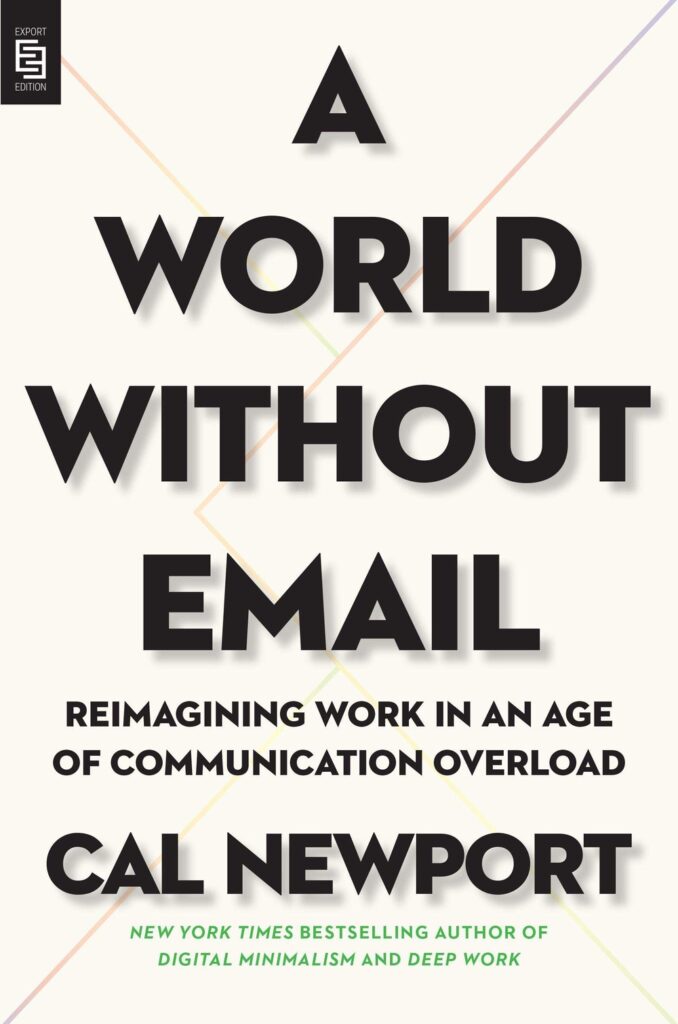Sharing my learnings from the book, A World Without Email by Cal Newport
A World Without Email by Cal Newport
We have become so used to an inbox-driven workday that it’s hard to imagine alternatives. But they do exist. Drawing on years of investigative reporting, author and computer science professor Cal Newport makes the case that our current approach to work is broken, then lays out a series of principles and concrete instructions for fixing it. In A World without Email, he argues for a workplace in which clear processes–not haphazard messaging–define how tasks are identified, assigned and reviewed. Each person works on fewer things (but does them better), and aggressive investment in support reduces the ever-increasing burden of administrative tasks. Above all else, important communication is streamlined, and inboxes and chat channels are no longer central to how work unfolds.

- the hyperactive hive mind workflow is characterized by a constant, ongoing conversation within an organization, in which employees’ activities are determined by the messages in their inboxes.
- On average, modern knowledge workers check their email once every six minutes. In total, they spend over a third of their working hours in their inboxes – an absolutely incredible amount of time!
- Clearly, the constant focus on email is disastrous for productivity. But why is that the case? Well, because of the human brain – specifically, a region called the prefrontal cortex, which is responsible for attention.
- The prefrontal cortex is only capable of focusing on one thing at a time. Yet the hyperactive hive mind workflow encourages us to maintain multiple ongoing electronic conversations, all while completing the difficult aspects of our jobs
- Psychologically, this takes a toll: rapidly switching between tasks takes time and energy. So when we multitask, we end up taking longer to complete each activity than we would if we were executing each one in isolation.
- Regardless of your profession, your work benefits when you have uninterrupted chunks of time for focused, creative thinking.
- there was a correlation between email and stress. The longer the workers spent on email within a given hour, the higher their stress was during that hour.
- The mental consequences of the hyperactive hive mind workflow go beyond a bit of stress here and there. It also has a huge impact on employees’ job satisfaction.
- When we ignore our emails, our brains think we’re neglecting our social connections and potentially endangering our own survival. As a result, we become anxious. In the hyperactive hive mind workflow, this anxiety is a constant presence, even at times when we’re supposed to be relaxing – at night, on weekends, or on vacation. To our ancient brains, an overloaded inbox feels like a literal matter of life and death. There simply must be a better solution
- To rid ourselves of the hyperactive hive mind, modern workplaces need a radical change like the assembly line. This will require a major shift in mindset toward workflows optimized for the human brain.
- attention capital, which refers to the human brains a company employs to generate value. The hyperactive hive mind workflow generates weak returns from this capital.
- an online project management tool enabled users to create shared pages called “boards,” each of which corresponded to a single project. All files, tasks, notes, and discussions attached to a project are collected within that project’s unique board. This workflow is optimized much better than the hyperactive hive mind for a few reasons. First, it encourages single-tasking over multitasking – employees can no longer get distracted by a hectic, overwhelming inbox. And second, the information on the project boards is neatly organized, making the workflow much more efficient.
- When changing an existing workflow, keep in mind that you’re always tweaking one of two things: work execution or expectations.
- Work execution involves the ways in which your employees do their jobs.
- When you’re altering work execution, it’s crucial to involve your employees in the process. The reason is the psychological theory of locus of control. This is the idea that when people feel like they have control over a particular course of action, they’re much more motivated to stick with it.
- While execution involves changing an entire team’s behaviors, you alter expectations with the way you do things individually.
- Clear, structured production processes maximize attention capital. Production processes can be organized differently depending on the nature of the work in question.
- automatic process, which is best for tasks that are repeated often and are highly structured
- For a more unstructured process, Using an online collaboration tool, he checks in on each of his team’s projects, joining in on conversations as needed.
- coordination protocol – a way of structuring communication. Every coordination protocol has an associated cost that’s worth close
- you can measure the cost of a coordination protocol by the degree to which it fragments your attention. This is measured in cognitive cycles.
- cognitive cycles aren’t the only relevant metric – so is inconvenience. Protocols that create long delays, require special effort, or lead to missed opportunities have high inconvenience costs.
- the hive mind protocol scores well on convenience, since firing off and responding to emails is quick.
- It’s important to ensure that your protocols strike the right balance between cognitive cycle and inconvenience costs. Once you’ve chosen a protocol, don’t be afraid to tweak it
- Highly skilled workers shouldn’t get bogged down in the administrative weeds. keep in mind the specialization principle: the concept that working on fewer things with a higher level of quality ultimately boosts productivity.


Leave a Reply